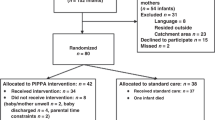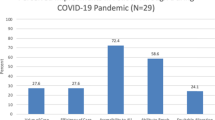Abstract
Objectives
The following are the objectives of this study: (1) Assess the feasibility and acceptability of emailing parent-reported measures of infant health and development after NICU discharge. (2) Examine whether post-discharge questionnaire data helps identify infants most likely to benefit from specialized follow-up care.
Study design
Parents of 51 infants <32 weeks’ gestation received email questionnaires at 44 weeks postmenstrual age (PMA) and 6 months corrected age (CA). Adverse infant outcomes were assessed in-person at 6 months: (1) Bayley-III cognitive or motor score <85; (2) weight, length, or head circumference <10th percentile; (3) new referral for medical or developmental services.
Results
Questionnaire response was 48 (94%) at 44 weeks PMA and 46 (90%) at 6 months CA. 36 (70%) infants were assessed at 6 months; 72% had at least 1 adverse outcome. Poorer transition home, feeding problems, and special health care needs at 44 weeks PMA predicted adverse outcomes. Feeding problems, maternal depression, and lower infant health-related quality of life at 6 months CA correlated with adverse outcomes.
Conclusions
Emailed questionnaires after NICU discharge were feasible to implement and acceptable to families. Repeated post-discharge assessments may help identify infants at heightened health and developmental risk.
This is a preview of subscription content, access via your institution
Access options
Subscribe to this journal
Receive 12 print issues and online access
$259.00 per year
only $21.58 per issue
Buy this article
- Purchase on Springer Link
- Instant access to full article PDF
Prices may be subject to local taxes which are calculated during checkout

Similar content being viewed by others
References
Mathews J. National vital statistics-births: final data 2006. In: Statistics NCfH, editor. Hyattsville” NCHS; 2006.
McCormick MC, Litt JS, Smith VC, Zupancic JA, Prematurity: an overview and public health implications. Annu Rev Public Health. 2012;32:367–79.
Milligan DW. Outcomes of children born very preterm inEurope. Arch Dis Child Fetal Neonatal Ed. 2010;95(4):F234–40.
Synnes AR, Anson S, Arkesteijn A, Butt A, Grunau RE, Rogers M, et al. School entry age outcomes for infants with birth weight </=800 grams. J Pediatr. 2010;157(6):989-94e1.
Follow-up Care. of High-risk infants. Pediatrics. 2004;114:1377–97.
Kuppala VS, Tabangin M, Haberman B, Steichen J, Yolton K, Current state of high-risk infant follow-up care in the United States: results of a national survey of academic follow-up programs. J Perinatol. 2011;32:293–8.
Rysavy MA, Li L, Bell EF, Das A, Hintz SR, Stoll BJ, et al. Between-hospital variation in treatment and outcomes in extremely preterm infants. N Engl J Med. 2015;372:1801–11.
Lapcharoensap W, Gage SC, Kan P, Profit J, Shaw GM, Gould JB, et al. Hospital variation and risk factors for bronchopulmonary dysplasia in a population-based cohort. JAMA Pediatr. 2015;169:e143676
Knapp C. e-Health in pediatric palliative care. Am J Hosp Palliat Care. 2010;27:66–73.
Costa C, Menesatti P, Brighetti MA, Travaglini A, Rimatori V, Di Rienzo Businco A, et al. Pilot study on the short-term prediction of symptoms in children with hay fever monitored with e-Health technology. Eur Ann Allergy Clin Immunol. 2014;46:216–25.
Benyakorn S, Riley SJ, Calub CA, Schweitzer JB. Current state and model for development of technology-based care for attention deficit hyperactivity disorder. Telemed J E Health. 2016 22:761–8.
Maleka BK, Van Der Linde J, Glascoe FP, Swanepoel W. Developmental screening-evaluation of an m-health version of the parents evaluation developmental status tools. Telemed J E Health. 2016;22:1013–8.
Lakshmanan A, Santo E, McCormick MC, Belfort M, Parental preference and ability to participate in web-based developmental screening and surveillance: preliminary evidence for preterm infants after NICU discharge. Clin Pediatr (Phila). 2014;53:1278–84.
Richardson DK, Gray JE, McCormick MC, Workman K, Goldmann DA, Score for Neonatal Acute Physiology: a physiologic severity index for neonatal intensive care. Pediatrics. 1993;91:617–23.
Coleman EA, Smith JD, Frank JC, Eilertsen TB, Thiare JN, Kramer AM, Development and testing of a measure designed to assess the quality of care transitions. Int J Integr Care. 2002;2:e02
DeMauro SB, Patel PR, Medoff-Cooper B, Posencheg M, Abbasi S, Postdischarge feeding patterns in early- and late-preterm infants. Clin Pediatr (Phila). 2011;50:957–62.
Bramlett MD, Blumberg SJ, Ormson AE, George JM, Williams KL, Frasier AM, et al. Design and operation of the National Survey of Children with Special Health Care Needs, 2009-2010. Vital Health Stat 1. 2014;57:1–271.
Schaper AM, Rooney BL, Kay NR, Silva PD, Use of the Edinburgh Postnatal Depression Scale to identify postpartum depression in a clinical setting. J Reprod Med. 1994;39:620–4.
Beck CT, The effects of postpartum depression on child development: a meta-analysis. Arch Psychiatr Nurs. 1998;12:12–20.
Mayer ML, Skinner AC, Slifkin RT, National Survey of Children With Special Health Care N. Unmet need for routine and specialty care: data from the National Survey of Children With Special Health Care Needs. Pediatrics. 2004;113:e109–15.
Fung EB, Samson-Fang L, Stallings VA, Conaway M, Liptak G, Henderson RC, et al. Feeding dysfunction is associated with poor growth and health status in children with cerebral palsy. J Am Diet Assoc. 2002;102:361–73.
Latal-Hajnal B, von Siebenthal K, Kovari H, Bucher HU, Largo RH, Postnatal growth in VLBW infants: significant association with neurodevelopmental outcome. J Pediatr. 2003;143:163–70.
Smith VC, Hwang SS, Dukhovny D, Young S, Pursley DM, Neonatal intensive care unit discharge preparation, family readiness and infant outcomes: connecting the dots. J Perinatol. 2013;33:415–21.
Belfort MB, Santo E, McCormick MC, Using parent questionnaires to assess neurodevelopment in former preterm infants: a validation study. Paediatr Perinat Epidemiol. 2013;27:199–207.
Sheldrick RC, Henson BS, Neger EN, Merchant S, Murphy JM, Perrin EC, The baby pediatric symptom checklist: development and initial validation of a new social/emotional screening instrument for very young children. Acad Pediatr. 2013;13:72–80.
Landgraf JM, Vogel I, Oostenbrink R, van Baar ME, Raat H, Parent-reported health outcomes in infants/toddlers: measurement properties and clinical validity of the ITQOL-SF47. Qual life Res: Int J Qual life Asp Treat, care Rehabil. 2013;22:635–46.
Harris PA, Taylor R, Thielke R, Payne J, Gonzalez N, Conde JG, Research electronic data capture (REDCap)--a metadata-driven methodology and workflow process for providing translational research informatics support. J Biomed Inform. 2009;42:377–81.
Group WMGRS. WHO Child Growth Standards: Length/height-for-age, weight-for-age, weight-for-length, weight-for-height and body mass index-for-age: Methods and development.. Geneva: World Health Organization; 2006.
Bayley N. Bayley Scales of Infant Development. 3rd ed. San Antonio, TX: Pearson Early Childhood; 2005.
Anderson PJ, De Luca CR, Hutchinson E, Roberts G, Doyle LW, Victorian Infant Collaborative G. Underestimation of developmental delay by the new Bayley-III Scale. Arch Pediatr Adolesc Med. 2010;164:352–6.
Khoo K, Bolt P, Babl FE, Jury S, Goldman RD, Health information seeking by parents in the Internet age. J Paediatr Child Health. 2008;44:419–23.
Epstein JN, Langberg JM, Lichtenstein PK, Kolb R, Altaye M, Simon JO, Use of an Internet portal to improve community-based pediatric ADHD care: a cluster randomized trial. Pediatrics. 2011;128:e1201–8.
Lane TS, Armin J, Gordon JS, Online recruitment methods for web-based and mobile health studies: a review of the literature. J Med Internet Res. 2015;17:e183.
Kuppala VS, Tabangin M, Haberman B, Steichen J, Yolton K, Current state of high-risk infant follow-up care in the United States: results of a national survey of academic follow-up programs. J Perinatol: Off J Calif Perinat Assoc. 2012;32:293–8.
Vohr BR, Wright LL, Dusick AM, Perritt R, Poole WK, Tyson JE, et al. Center differences and outcomes of extremely low birth weight infants. Pediatrics. 2004;113:781–9.
Funding
This study was funded by a grant from the Center for Patient Safety and Quality Research and by the Division of Newborn Medicine, both at Boston Children’s Hospital.
Author information
Authors and Affiliations
Corresponding author
Ethics declarations
Conflict of interest
The authors declare that they have no competing interests.
Rights and permissions
About this article
Cite this article
Litt, J.S., Agni, M., Jacobi-Polishook, T. et al. The acceptability and feasibility of emailed parent questionnaires for medical and developmental surveillance after NICU discharge. J Perinatol 38, 392–401 (2018). https://doi.org/10.1038/s41372-017-0022-6
Received:
Accepted:
Published:
Issue Date:
DOI: https://doi.org/10.1038/s41372-017-0022-6
This article is cited by
-
Follow-through care for high-risk infants during the COVID-19 pandemic: lessons learned from the Vermont Oxford Network
Journal of Perinatology (2021)
-
NICU infant health severity and family outcomes: a systematic review of assessments and findings in psychosocial research
Journal of Perinatology (2019)



